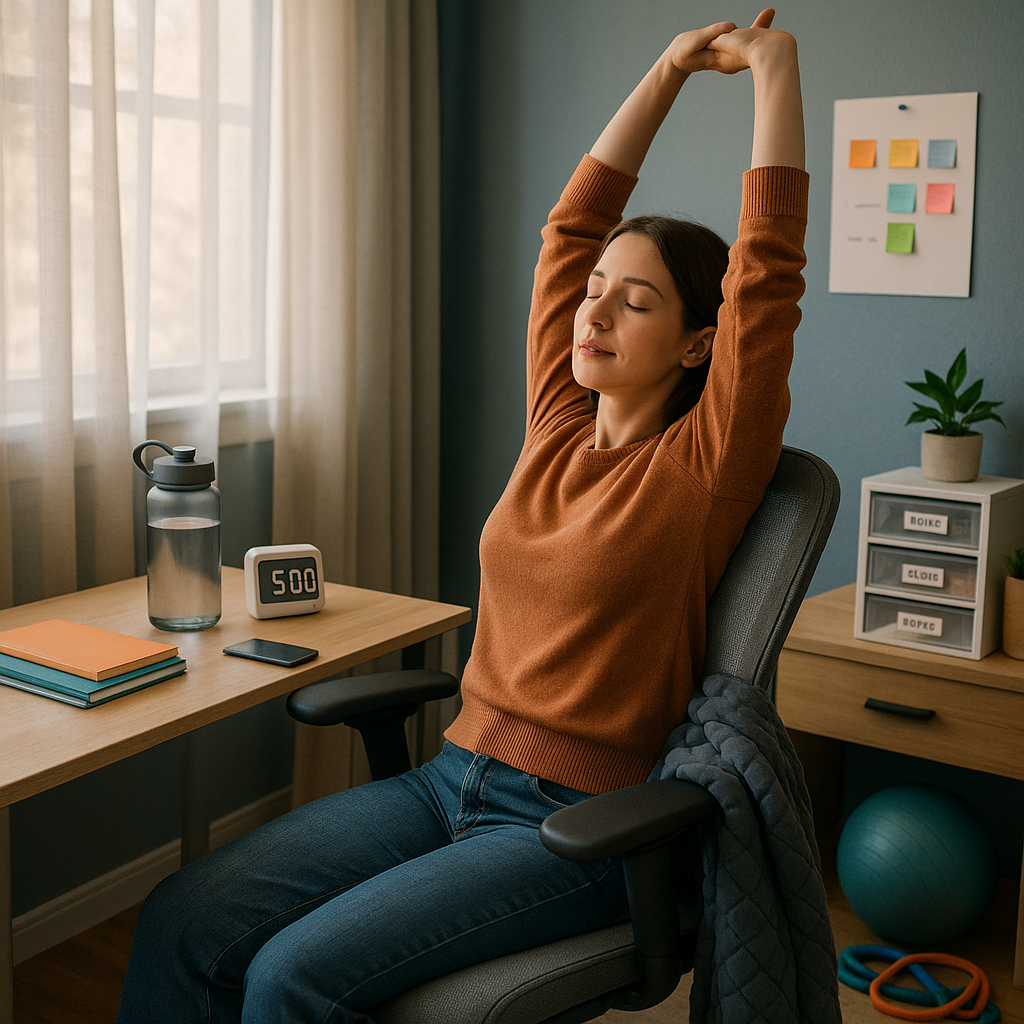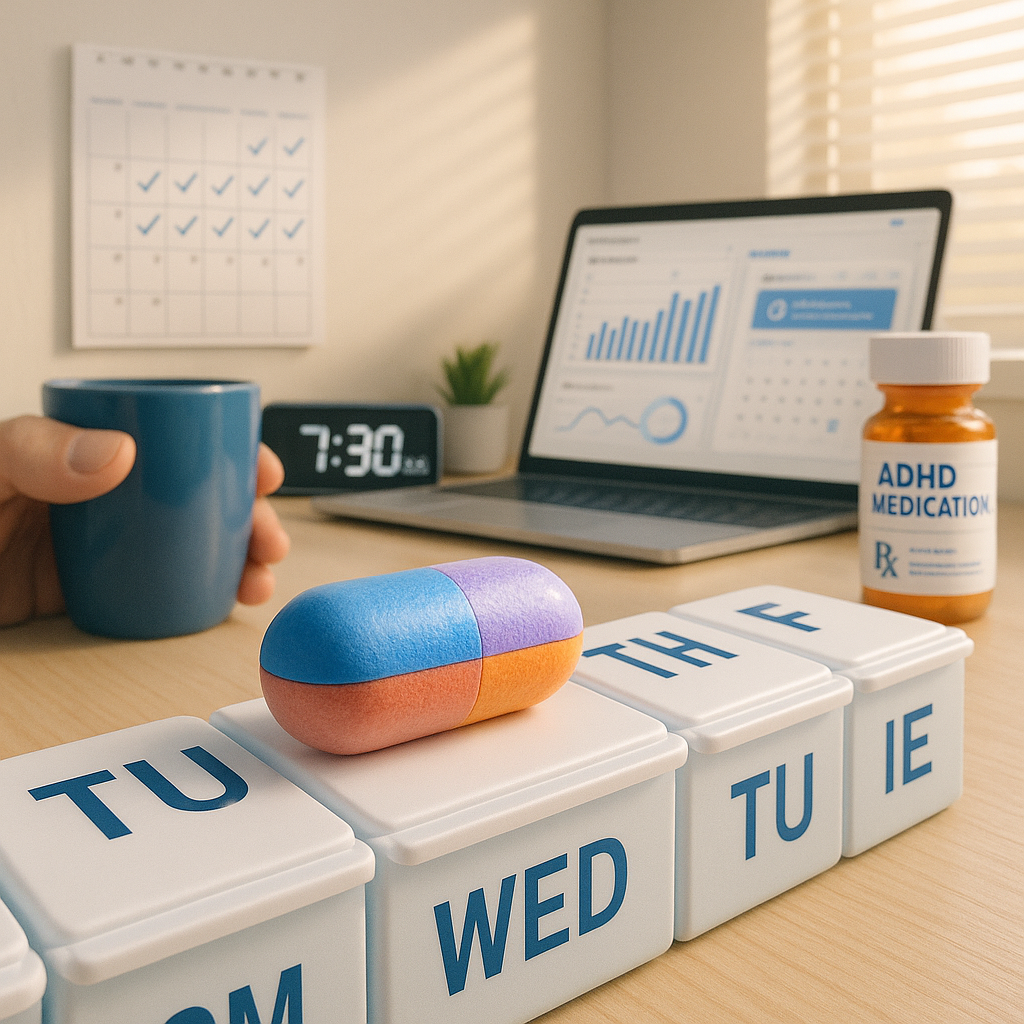Key Takeaways
-
Redefine self-care as essential, not optional: For ADHD minds, self-care forms the core foundation for functioning. It is not a luxury, but a baseline necessity. Shifting your mindset to view these habits as non-negotiable anchors for wellness and resilience can be transformative.
-
Choose routines with low friction and high payoff: ADHD-friendly self-care thrives on practices that require minimal setup and willpower yet offer significant mental health rewards. Prioritize five-minute resets, micro-movements, or single-focus mindfulness over elaborate rituals.
-
Spot and disrupt burnout triggers early: Recognizing both emotional and physical cues of ADHD burnout empowers you to intervene swiftly, using supportive routines before overwhelm escalates.
-
Harness anxiety reduction as daily maintenance: Integrating simple, routine actions such as breathing exercises, sensory tools, or calming visuals helps regulate your nervous system, reducing anxiety and the chance of shutdowns.
-
Break down self-care into bite-sized steps: Dismantle overwhelming wellness goals into micro-actions. For example, let “move your body” mean a 30-second stretch or make “organize” as simple as clearing one shelf.
-
Make movement playful and pressure-free: Let go of rigid fitness standards. Embrace body-doubling walks, spontaneous dance breaks, or in-the-moment stretching to support dopamine regulation and stress relief, freeing yourself from perfectionism.
-
Lean into personalized, ADHD-specific wellness: The most effective self-care is customized. Track which habits feel genuinely good for your brain, energy, and emotions, and adapt your toolkit regularly.
-
Honor gendered experiences of guilt and care: Women and gender minorities with ADHD often internalize extra guilt, putting their needs last. Recognizing and validating these patterns creates space to reclaim your right to recharge.
-
Start small and celebrate tiny wins: Move away from all-or-nothing thinking by acknowledging every bit of progress. Small acts of care help you build sustainable momentum for long-term ADHD wellness.
-
Build self-compassion into every habit: Accept setbacks as part of the journey. Practicing gentleness with yourself dissolves shame, which is the largest barrier to lasting self-care.
By focusing on practical, forgiving habits and acknowledging hidden emotional barriers (including those influenced by gender), these key takeaways pave the way for realistic, scalable routines that support every ADHD brain. Now, let’s explore actionable self-care strategies tailored to leave guilt behind, nurturing true, lasting wellbeing.
Introduction
For ADHD minds, self-care is much more than a nice-to-have. It’s a survival strategy. If you’ve ever felt sidelined by guilt, overwhelm, or the pressure to do self-care “right,” know that you’re in good company. Navigating self-care with ADHD means wrestling not just with distractions, but with expectations that label everyday routines as “easy,” even when they require Olympic-level effort from you.
Genuine ADHD wellness grows from habits that honor your natural wiring: tiny, flexible, and welcoming to imperfection. This guide skips the pressure to meditate flawlessly or follow rigid regimens. Instead, you’ll discover ten ADHD-friendly self-care strategies that are practical, approachable, and laser-focused on reducing burnout and boosting mental health. Let’s show how compassionate routines and self-acceptance can become daily superpowers.
Understanding ADHD Burnout & The Self-Care Imperative
Before diving into practical strategies, it’s important to understand the unique connection between ADHD and burnout. Executive function differences mean that, for ADHD brains, even routine tasks can require extra effort. Imagine your brain as a laptop running with every program open at once. It doesn’t just need periodic reboots; it demands structured downtime to avoid overheating.
Common ADHD burnout signals include:
- Tasks you once enjoyed suddenly feel insurmountable
- Emotions intensify and become harder to regulate
- Decision-making turns overwhelming, even for basic choices
- Physical symptoms such as headaches and fatigue become frequent
- Executive function skills deteriorate beyond your “normal” ADHD challenges
Recognizing these burnout signs isn’t just helpful. It’s crucial. Early intervention with supportive routines allows you to prevent a full shutdown, making self-care a powerful line of defense.
The Gender Gap in Self-Care Guilt
For many women and gender minorities with ADHD, self-care involves overcoming not only neurodivergent challenges but also societal expectations around caregiving, productivity, and sacrifice. Research consistently finds women are more prone to postponing their own care, feeling disproportionate guilt when they take time for themselves.
Acknowledging this double standard is an essential step in creating self-care systems that feel safe and sustainable. By naming this struggle, you unlock permission to prioritize wellbeing without apology or shame.
Breaking Down the 10 Guilt-Free Self-Care Habits
To build self-care that sticks, focus on gentle, adaptive habits that mesh with real life. These evidence-based strategies are not only ADHD-friendly but also customizable across various lifestyles and work environments.
1. Micro-Movement Moments
Physical activity is a proven tool for managing ADHD symptoms, yet traditional fitness plans can feel impossible to maintain. Embrace brief movement “snacks” to integrate activity into your routine:
- Dance to a single song while making coffee
- Stretch during virtual meetings (camera off is welcome)
- Slot in five-minute walking breaks between work tasks
- Try simple desk stretches during long periods of focus
By ditching the “all-or-nothing” approach, you transform movement into an accessible dopamine boost instead of an overwhelming obligation. In fields such as healthcare or education where time is scarce, micro-movement offers accessible wellness for professionals and students alike.
2. Strategic Rest Points
Rest is not a luxury for an ADHD brain; it’s vital maintenance. Plan intentional breaks throughout your day to protect against energy crashes:
- Schedule ten-minute “brain breaks” between deep work sessions
- Set reminders using timer apps for consistent pauses
- Designate a cozy reset spot in your home or workspace
- Enjoy guilt-free naps (ideally under 20 minutes) to reboot your mind
Prioritizing downtime enhances focus, creativity, and emotional regulation. In demanding sectors like tech or finance, regular rest points elevate productivity and resilience.
3. Sensory Comfort Practices
ADHD often heightens sensitivity to environmental stimuli, leading to increased fatigue or stress. Construct a sensory toolkit to support your unique preferences:
- Keep noise-canceling headphones within reach
- Use weighted blankets for calming during work or rest
- Choose clothing that feels soothing instead of just looking good
- Adjust lighting to favor gentle, non-stimulating tones
Such accommodations make it possible to thrive at home, in open offices, or any setting where sensory overload is possible.
4. Minimal-Effort Nutrition Support
Nutrition directly impacts ADHD performance; yet elaborate meal prep is rarely sustainable. Opt for nutrition strategies that minimize barriers:
- Stock up on grab-and-go protein snacks
- Use meal delivery services to reduce overwhelm
- Place water bottles in common spots for frequent hydration
- Prioritize balanced, “good enough” meals rather than perfection
Whether you’re a busy parent, student, or executive, small shifts in food routines provide consistent energy and focus.
5. Digital Boundaries for Brain Health
The ADHD brain is highly sensitive to digital overload, often resulting in scattered focus and fatigue. Build tech boundaries that feel gentle yet effective:
- Set app timers to limit excessive scrolling rather than imposing total bans
- Create phone-free zones (like bedrooms or the dining table)
- Schedule specific times to check emails or messages
- Utilize “do not disturb” features generously to block distractions
This digital hygiene practice maintains focus and calm in our hyper-connected work and leisure environments.
6. Compassionate Organization Systems
Rather than imposing rigid order, create organizing methods that embrace ADHD’s natural tendencies:
- Rely on visual organizing tools such as labeled bins or color-coded notes
- Set up “drop zones” for keys, wallets, and other essentials
- Use the “one in, one out” rule to avoid clutter creep
- Aim for “good enough” tidiness so that your space feels functional, not flawless
Such systems support independence and ease for anyone who struggles with executive function, whether in business, healthcare, or creative fields.
7. Social Energy Management
Social interactions often present a double-edged sword for ADHD individuals, providing both joy and exhaustion. Practice social energy management for healthier boundaries:
- Schedule intentional downtime after social engagements
- Leverage voice messages or texts instead of live phone calls
- Arrange brief, regular check-ins to sustain connections without overwhelm
- Communicate your energy limits openly with friends and family
Recognizing your personal social rhythm prevents burnout and deepens meaningful relationships.
8. Creative Expression Outlets
Creativity is a powerful form of emotional processing for many neurodivergent minds. Make creative pursuits low-pressure and readily available:
- Keep basic art materials accessible for spontaneous creativity
- Use voice recording apps to quickly capture fleeting thoughts or feelings
- Try adult coloring books or doodling during meetings to calm the mind
- Explore dance, music, or crafts as joyful expression without performance pressure
Encouraging creativity supports emotional health in personal life and fosters innovation in problem-solving across sectors such as marketing, education, and beyond.
9. Time Abundance Practices
ADHD brains often struggle with time-blindness and over-committing. Instead of rigid schedules, try time management routines built on flexibility and abundance:
- Slot extra “buffer” time between meetings or appointments
- Use time-blocking frameworks, but adapt them as needed
- Schedule regular “catch-up” days to reset workloads and reduce backlog stress
- Practice saying “no” as a conscious act of self-preservation
Creating space improves your ability to focus on what matters, a principle relevant whether you’re managing a start-up, leading a team, or balancing family life.
10. Bedtime Rituals That Actually Work
Sound sleep is critical for managing ADHD symptoms, but sleep routines must feel realistic to stick. Design an evening ritual tailored to your patterns:
- Set a consistent “shutdown sequence” to wind down nightly activities
- Use calming audio content (podcasts, stories, music) to soothe racing thoughts
- Keep your bedroom free of stimulating distractions
- Respect your natural variations in sleep timing instead of striving for generic norms
Better rest leads to improved concentration, mood, and resilience. These benefits extend from home to every corner of professional life.
Each strategy above can be adapted for different settings, job roles, and life stages, making them invaluable whether you’re a solopreneur, healthcare worker, student, or creative.
Conclusion
Redefining self-care as a non-negotiable for ADHD is an act of empowerment, not indulgence. By embracing micro-movements, strategic rest, sensory accommodations, and compassionate organization, you break free from the myth of perfectionist self-care. Instead, you build a toolkit uniquely attuned to your brain’s genuine needs. For women and gender minorities facing additional guilt, these practical tools replace shame with self-compassion, offering a blueprint for real sustainability.
But this isn’t a static solution. Sustainable self-care for ADHD requires ongoing adaptation and the courage to let small acts count. The real transformation begins when you grant yourself permission to become your own priority, celebrating each tiny win and letting each setback fuel future growth.
As you refine these habits, you don’t just prevent burnout; you unlock a path toward greater resilience, creativity, and success. In life, business, and beyond, looking ahead, the ever-evolving landscape of neurodivergent wellness invites you to leverage your unique strengths, personalize your routines, and advocate for environments that support your needs. In doing so, you lead the way for others to redefine productivity and creativity on their own terms. The question isn’t whether you deserve this level of care. It’s how boldly you’ll claim it and use it to let your ADHD brilliance spark real change.





Leave a Reply